As an Amazon Associate DcSoundOp earns from qualifying purchases.
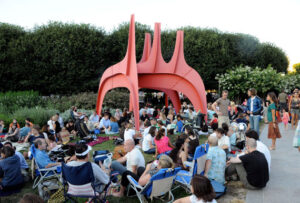 In this post I’ll be sharing an inside look at an interesting system installed at the National Gallery of Art here in Washington D.C. The system was designed by Onyx Audio out of Richmond, VA. and is deployed and operated by the NGA staff as needed. This specific system is one of many in-use around various parts of the Gallery and solely serves the Sculpture Garden at the west end of the NGA complex which spans six city blocks along the National Mall. The primary function for this system is to meet the needs of both regional and national acts who come to perform at the Gallery during the Friday night summer concert series “Jazz In The Garden” that takes place every week from May through September. Although
In this post I’ll be sharing an inside look at an interesting system installed at the National Gallery of Art here in Washington D.C. The system was designed by Onyx Audio out of Richmond, VA. and is deployed and operated by the NGA staff as needed. This specific system is one of many in-use around various parts of the Gallery and solely serves the Sculpture Garden at the west end of the NGA complex which spans six city blocks along the National Mall. The primary function for this system is to meet the needs of both regional and national acts who come to perform at the Gallery during the Friday night summer concert series “Jazz In The Garden” that takes place every week from May through September. Although 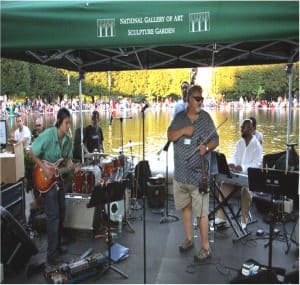 the garden space holds roughly 4500 guests attending at any one time, on a good Friday night the event will see a total attendance of around fifteen thousand concert goers.
the garden space holds roughly 4500 guests attending at any one time, on a good Friday night the event will see a total attendance of around fifteen thousand concert goers.
The entire installed system itself consists of three independent parts, which each serve different purposes throughout the calendar year. The main “Concert System” used for JITG (Jazz In The Garden) events is comprised of a primary “Live Event” system along with two secondary sound systems which are interconnected in order to allow them to be used as one larger system as required by the JITG concert series. The three independent systems that are in place are a) The Cafe System, b) The Garden Zone System, and c) The Live Event System. This functionality is made possible through a combination of networked audio routing, and a rather simple switched DSP located in the Amp/Control Room below the complex.
The smallest system is the one serving the Garden Cafe. The Cafe is open daily to visitors, and requires light back-round music and occasional paging functionality throughout normal everyday operation. Within this system there are multiple zones for different areas of the Cafe, each with independent volume control. During a Live Event, the back-round music must be switched off and the system must become a single (zone) of the larger concert system, providing patrons in the cafe with the same program and announcements etc. as the outdoor concert audience. This year (2012) the cafe system has undergone a considerable upgraded from simple 70v paging speakers, to more robust 70V ceiling speakers capable of handling music at better levels, along with the addition of two small format (Dual 10″) installation subwoofer cabinets to round out the bottom end. The system includes a lockable wall mounted control rack in the kitchen area allowing the cafe manager access to adjust each zone or the overall master volume. This rack also includes the Muzak receiver where they select their back-round music along with inputs and level controls for a paging microphone and a 1/8″ line-in for local i-pod hookups.
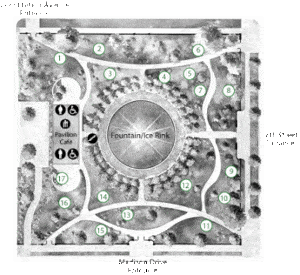 The second and physically largest system is the outdoor Garden System, which is essentially just another zone of speakers, although in use, things get a bit more complicated. The actual installed system consists of nearly thirty Technomad outdoor boxes mounted in different “rings” following the curvature of the circular fountain throughout the Garden. These boxes are a mix of both 70V and conventional boxes, each accommodating the different needs of the various zones within the Garden space. Typically throughout a normal day, this system is not in use, but during the winter months the Sculpture Garden hosts an ice-skating rink in the center of the space where the large (100’+ diameter) water fountain is located. During the ice-skating season, the sound system is used for back-round music and light paging duties, typically, but not always, taking it’s program feed from the Cafe (kitchen) control position. It is a simple push of a button on the DSP that links this system to the Cafe system, beyond that, there are DSP presets allowing use of all of the outdoor zones, or just certain zones within the system. The ice-skating setup is a good example of this, as for this use it is desirable to have music playing for those ice-skating within the rink, but the outer ring of speakers located amongst the art installations along the perimeter of the garden would be a distraction to those visiting to view the art.
The second and physically largest system is the outdoor Garden System, which is essentially just another zone of speakers, although in use, things get a bit more complicated. The actual installed system consists of nearly thirty Technomad outdoor boxes mounted in different “rings” following the curvature of the circular fountain throughout the Garden. These boxes are a mix of both 70V and conventional boxes, each accommodating the different needs of the various zones within the Garden space. Typically throughout a normal day, this system is not in use, but during the winter months the Sculpture Garden hosts an ice-skating rink in the center of the space where the large (100’+ diameter) water fountain is located. During the ice-skating season, the sound system is used for back-round music and light paging duties, typically, but not always, taking it’s program feed from the Cafe (kitchen) control position. It is a simple push of a button on the DSP that links this system to the Cafe system, beyond that, there are DSP presets allowing use of all of the outdoor zones, or just certain zones within the system. The ice-skating setup is a good example of this, as for this use it is desirable to have music playing for those ice-skating within the rink, but the outer ring of speakers located amongst the art installations along the perimeter of the garden would be a distraction to those visiting to view the art.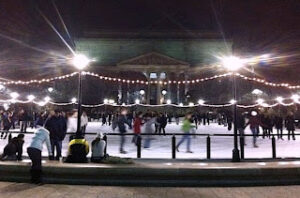
So, having covered two of the three systems and their functionality, we can delve into the actual concert system and it’s capabilities. The concert system is conceptually a very simple system, the deployment and interconnectivity is what makes it both unique and powerful for the purpose it serves. The concert system is essentially a simple 16 input system providing 4 monitor mixes back to the stage along with a master L/R program mix. The system is based around a humble Yamaha LS9-16 console, and a number of powered speakers (mostly QSC K10 boxes) which are deployed along with a few powered subs (Electro-Voice) to supplement and fill out the zoned Technomad system that is permanently installed in the outdoor Garden space.
As you may notice from the attached photos, the FOH rack is quite sparse, including only the console, a CD player and a couple of Aviom i/O units. 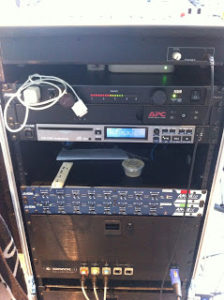 The Aviom units are where things begin to get interesting with the concert system. Although by current (2012) standards, this system design may seem a bit clunky, when the LS-9 came to market, this was one of the few options for deploying a digital snake system, and utilized some of the latest technology available in digital networked audio.
The Aviom units are where things begin to get interesting with the concert system. Although by current (2012) standards, this system design may seem a bit clunky, when the LS-9 came to market, this was one of the few options for deploying a digital snake system, and utilized some of the latest technology available in digital networked audio. 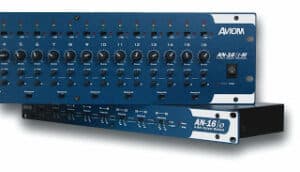 The heart of the system is an Aviom AN-16/i-m located in a portable stage rack, this provides 16ch of mic-pres, handles the A/D conversion and sends it all up to FOH position where an Aviom AN-16/O lives. The AN-16/O converts the 16ch back to analog (TRS), which using a small TRS-XLR snake, connects to the LS9 mic inputs. It is clunky with the extra D/A step at FOH, but at the time of design, this was an acceptable trade off (more to come on this in a moment). Likewise, at FOH there is an Aviom AN-16/i which takes the omni outputs from the console converts them and delivers them back to the stage box where there is another AN-16/O handling the D/A for those returns to the stage monitors and other powered speakers. An upgrade to the newer PRO64 Protocol is in the works for this system, which will allow the use of an Aviom Card in the LS9-16’s single slot to handle both in and out needs without the extra conversion steps. Adding remote pre-amp control with the new PRO64 series will help ease the current problems associated with having two gain stages to set for each input… one of which is 100′ away.
The heart of the system is an Aviom AN-16/i-m located in a portable stage rack, this provides 16ch of mic-pres, handles the A/D conversion and sends it all up to FOH position where an Aviom AN-16/O lives. The AN-16/O converts the 16ch back to analog (TRS), which using a small TRS-XLR snake, connects to the LS9 mic inputs. It is clunky with the extra D/A step at FOH, but at the time of design, this was an acceptable trade off (more to come on this in a moment). Likewise, at FOH there is an Aviom AN-16/i which takes the omni outputs from the console converts them and delivers them back to the stage box where there is another AN-16/O handling the D/A for those returns to the stage monitors and other powered speakers. An upgrade to the newer PRO64 Protocol is in the works for this system, which will allow the use of an Aviom Card in the LS9-16’s single slot to handle both in and out needs without the extra conversion steps. Adding remote pre-amp control with the new PRO64 series will help ease the current problems associated with having two gain stages to set for each input… one of which is 100′ away.
What was gained in putting up with the additional A/D & D/A steps is the ability to send 16 channels (bi-directionally) from the console to the stage, utilizing only two pieces of CAT-5 cabling. This comes into play, as the physical layout of the Garden, including the water fountain etc. demands that all interconnect cabling used must be permanently installed below grade in conduit. There is simply no way to run an analog snake for each event within the allotted setup time. The conduit paths needed were already in-place from the original installation, but didn’t have enough room left to handle a traditional copper snake. As this system was essentially an expansion of the existing 70V paging system and was designed to handle the growing needs of the space, making the most out of what was currently in-place was of paramount importance, as the budget would simply not allow digging up the sculpture garden to expand the conduit paths. 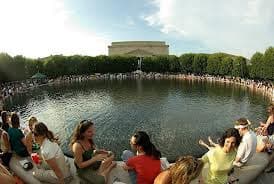 Beyond that, Even if the conduit had allowed a traditional snake, keeping an analog patch panel, mass connector or similar i/o point safe and dry (not to mention hidden) in an outdoor gallery space would have been far more costly over the life of the system. RJ-45 connectors are small, cheap, and quickly replaced (even while setting up for an event) if found damaged. They are also simple for any staff member to connect without prior training (not the case with a mass connector). A major design goal was to ensure that the concert system in it’s entirety can be completely deployed and operational in just under two hours, each time it is used.
Beyond that, Even if the conduit had allowed a traditional snake, keeping an analog patch panel, mass connector or similar i/o point safe and dry (not to mention hidden) in an outdoor gallery space would have been far more costly over the life of the system. RJ-45 connectors are small, cheap, and quickly replaced (even while setting up for an event) if found damaged. They are also simple for any staff member to connect without prior training (not the case with a mass connector). A major design goal was to ensure that the concert system in it’s entirety can be completely deployed and operational in just under two hours, each time it is used.
The next evolution with this system was to install permanent (weather-proof) patch locations at various positions outdoors and also inside the Garden Cafe space, and route all of the CAT-5 lines (color coded of course) through a simple network frame patch bay (located with the DSP in the amp room). This allows the Stage Box or FOH rack to deployed in a variety of locations, while maintaing the same audio paths. Accommodating a different physical layout is as simple as re-configuring a few jumpers at the patch-bay. This functionality allows relocating FOH, or even the entire system (stage included) indoors to the cafe space, should weather not allow setup outdoors in the Garden.
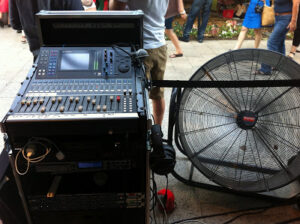 With the system setup as described, tying in the concert system and switching over the Cafe & Garden zoned systems to act as one big system can be accomplished in under 10 minutes, with a single technician. The FOH rack is simply deployed at a desired location, two CAT5 cables along with 120V A/C power are connected at the patch point and we’re set. The Stage Rack gets deployed at it’s desired location and the same three connections are made, after that a simple selection is made at the Patch-Bay & DSP and the entire system is now acting as one, now taking it’s source from the FOH mixer. At this point the system is functional and the crew can move on to setting up the additional powered speakers that were mentioned earlier to supplement the installed outdoor zoned speakers.
With the system setup as described, tying in the concert system and switching over the Cafe & Garden zoned systems to act as one big system can be accomplished in under 10 minutes, with a single technician. The FOH rack is simply deployed at a desired location, two CAT5 cables along with 120V A/C power are connected at the patch point and we’re set. The Stage Rack gets deployed at it’s desired location and the same three connections are made, after that a simple selection is made at the Patch-Bay & DSP and the entire system is now acting as one, now taking it’s source from the FOH mixer. At this point the system is functional and the crew can move on to setting up the additional powered speakers that were mentioned earlier to supplement the installed outdoor zoned speakers.
With time being of the essence in setting up, along with the need to not have interconnect cabling cross foot traffic areas, the supplemental speakers are handled in a unique way to further simplify deployment. Utilizing CAT5 cable, along with Balun boxes (details below) and the same network patch bay, it is possible to send (ANALOG) line level signal directly to the supplemental powered speakers. At each speaker location, there is an installed CAT5 patch point along with A/C power for the powered speakers, it should be noted that all of the mentioned patch locations in the system are identical in design. Located each within a double-gang waterproof housing are two color coded connections for the Aviom system (RED/GREEN), a connection for the powered speakers (WHITE), with one additional CAT5 connection as a backup (BLUE) along with a single duplex 120V A/C outlet. This type of simplicity and continuity of design allows for both flexibility and redundancy should something need to move or should a patch point or specific run of cable become damaged or non-functional.
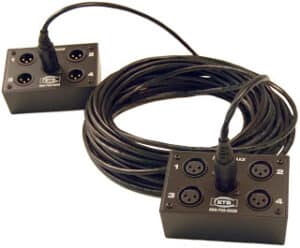 In the case of the powered speakers, it’s a single mono (full range) program feed from the DSP taken through a Balun box which puts it on a CAT5 cable (WHITE), which then hits the patch-bay and is split from there (passivly) to all of the (WHITE) connectors in the various patch boxes around the venue. At each powered speaker location the (WHITE) CAT5 gets patched to a Balun box that converts it back to XLR, which in-turn connects first to the powered sub input and is then patched from the sub up to it’s corresponding mid/hi box using the built in x-over in the powered sub to handle dividing the pass bands.
In the case of the powered speakers, it’s a single mono (full range) program feed from the DSP taken through a Balun box which puts it on a CAT5 cable (WHITE), which then hits the patch-bay and is split from there (passivly) to all of the (WHITE) connectors in the various patch boxes around the venue. At each powered speaker location the (WHITE) CAT5 gets patched to a Balun box that converts it back to XLR, which in-turn connects first to the powered sub input and is then patched from the sub up to it’s corresponding mid/hi box using the built in x-over in the powered sub to handle dividing the pass bands.
**For those who are unfamiliar with this technique, there are many companies who make this technology available in simple and cost effective hardware. With a set of Balun boxes costing around $100/set, you can send up to 4 channels of analog audio (line or mic level) passively & bi-directionally, requiring no power at either end, to distances close to two thousand feet using a single piece of CAT5 or CAT6 cable.**
Using this type of simple technology in tandem with more complex and pricey digital audio network is a fantastic way to solve the simple problems and overcome limitations often encountered when relying on networked audio for your path between stage and control positions.
The physical layout of the system was designed with special attention being paid to keeping the various components out of sight for visitors to the garden. Above all other functions, this space is an art gallery, and is treated as such throughout it’s design. The layout of the garden itself, the landscape design, the multitude of installation art pieces and the live music performances are all different art forms that are displayed in unison to the public, free of charge. The individual sound systems are all designed in connection with their surrounding spaces; the landscape design accommodates the installed speakers by hiding them from view in most locations, the architectural design was considered in choosing where to place the powered supplemental speakers for live events where they could be effective yet unobtrusive. When you look at the stage from any angle, there is nothing that appears to be a traditional PA system blocking the view, yet when you pass in-front of the stage, the system sounds and feels like a proper (stacked on the corners of the stage) PA system should. It’s always fun to fire up a track like Pat Metheny’s “Last Train Home” when I first assemble the system and walk throughout the garden, listening as sound fills the various spaces.
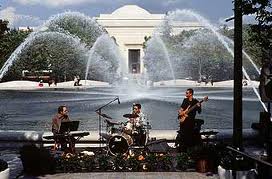 That’s the whole system in a nutshell, it’s a great example of smart design and creative problem solving being applied to an installed sound system. To the end-user, concert goer and general gallery visitor, at most they will only ever see a simple looking system delivering a simple result, quality audio. The complexity of pulling this off in a real world design can be hard to comprehend for anyone not already in the know. Designing multiple systems that perform an array of varying tasks, scale easily, offer the correct amount of control for each task, integrate seamlessly with an existing infrastructure and do so reliably while playing nice with each other when needed, is a daunting task to say the least. Doing all of that while keeping it out of sight and within a reasonable budget is just plain impressive.
That’s the whole system in a nutshell, it’s a great example of smart design and creative problem solving being applied to an installed sound system. To the end-user, concert goer and general gallery visitor, at most they will only ever see a simple looking system delivering a simple result, quality audio. The complexity of pulling this off in a real world design can be hard to comprehend for anyone not already in the know. Designing multiple systems that perform an array of varying tasks, scale easily, offer the correct amount of control for each task, integrate seamlessly with an existing infrastructure and do so reliably while playing nice with each other when needed, is a daunting task to say the least. Doing all of that while keeping it out of sight and within a reasonable budget is just plain impressive.
-dcSoundOp-(2012)
Amazon and the Amazon logo are trademarks of Amazon.com, Inc, or its affiliates.
